Bosch GET 55-125 Review
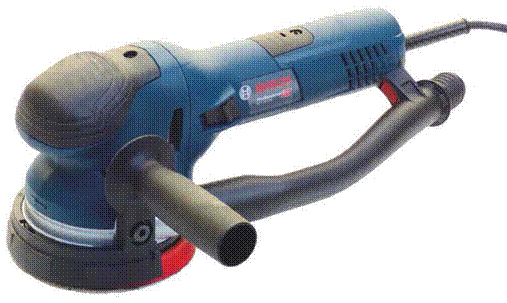
Described by Phil Davy as a first rate sander, the Bosch GET 55-125 features a perfectly designed ergonomic palm rest and handle along with two sanding modes. Read our Bosch GET 55-125 Review.

Bosch GET 55-125 Professional random orbit sander
Even though a mains-powered sander may not be so convenient as a cordless equivalent, there are several advantages. Whether in a workshop situation or on site you obviously don’t need to consider recharging batteries.
If you use a range of cordless tools it’s more than likely these will share the same battery platform, with a drill/driver probably among the most frequently used. If that’s the case, you’ll know how pricey two or three batteries can be. A couple of pro high capacity lithium batteries is likely to set you back well over £. Unless you’re well disciplined, it can get frustrating should you forget to keep batteries on charge. A cordless sander can drain batteries quickly, while a 230V version will give constant performance and power.
Body grip
The smaller of two new random orbit sanders from Bosch, the GET 55-125 features a disc diameter of 125mm, or thereabouts. If you need to sand big areas, the GET 75-150 may
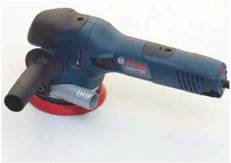
A long, slim plastic body makes the tool comfortable to hold, while at the front there’s a large hand grip that’s shrouded in rubber
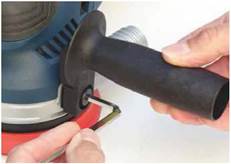
You also get a removable auxiliary handle, which can be fitted to either side of the sander
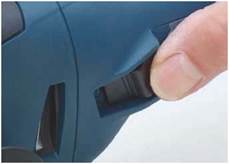
Located on the left side of the body, the positive on/off slider switch is operated with your thumb – not so convenient for left-handers
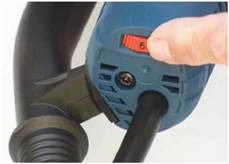
At the rear of the tool is the speed dial, which is easy to see and use
be a better bet, with 150mm disc. Surprisingly at this price there’s no heavy-duty plastic storage case, just a cardboard box. Fine if you rarely need to use tools away from the workshop.
A long, slim plastic body makes the tool comfortable to hold, while at the front there’s a large hand grip that’s shrouded in rubber.
Below this are cooling vents for the 550W motor, which features constant electronics to maintain consistent orbital stroke rate. You also get a removable auxiliary handle, which can be fitted to either side of the sander. Attached with a large machine screw, an oversized hex key is included, though there’s nowhere to store this.
Located on the left side of the body, the positive on/off slider switch is operated with your thumb, not so convenient for left-handers. At the rear of the tool is the speed dial, easy to see and use. With a speed range from 3,300-7,800rpm, orbit diameter is 3.5mm. Overall weight of the tool is 2.5kg, while cable length is a generous 4m.
Bosch backing pads
One of the differences between budget and professional sanders is often the backing pad, which can be on the thin side on cheaper tools. On this Bosch model it’s 13mm thick, consisting of dense polyurethane cushioning attached to rigid plastic. Fixed to the tool with a hex screw, it has a protective rubber rim and contains an array of holes for dust collection. These work particularly well with mesh sanding discs, of which just one (120 grit) is included. A medium grade pad is standard with the tool for general sanding applications. Options include hard pads for heavy sanding tasks and soft ones for polishing and working curved surfaces.
All feature hook-and-loop fixing.
A plastic guard ring clips around the front of the pad to protect it when sanding close to vertical edges. It’s easily removed if you don’t need it.
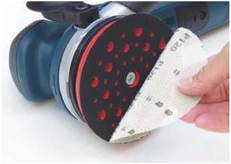
The backing pad is attached to the tool with a hex screw; it has a protective rubber rim and contains an array of holes for dust collection

A plastic guard ring clips around the front of the pad to protect it when sanding close to vertical edges
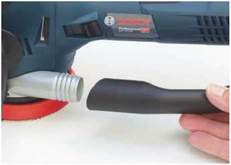
On the Bosch sander there’s a ribbed dust port (about 25mm) built into the alloy casing
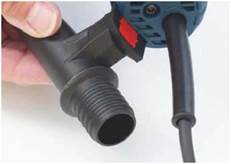
The dust port connects to a long plastic tube, which is clipped on to the rear of the sander and ends in a similar port
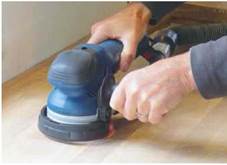
Hooked up to my Trend vacuum extractor, there was hardly any dust visible when sanding an oak kitchen worktop
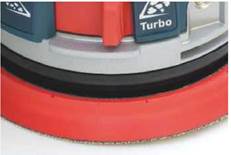
On the GET 55-125 sliding a beefy switch on its right, just above the backing pad, changes it over to a far more aggressive action
Professional sanders seem to be moving away from removable fabric dust bags, which are not always that efficient and can deteriorate over time. Instead, larger tools now tend to have dust outlets designed to be used with a vacuum extractor. No doubt manufacturers are keen to sell you another product for the workshop, though these portable systems are generally healthier and more effective. On the Bosch sander there’s a ribbed dust port (about 25mm) built into the alloy casing. It connects to a long plastic tube, which is clipped on to the rear of the sander and ends in a similar port. Assuming you have a suitable adaptor, this gives two ways of connecting an extractor. Hooked up to my Trend vacuum extractor, there was hardly any dust visible when sanding an oak kitchen worktop. In fact, you could probably get away without wearing a face mask indoors.
Turbo technology
But the major difference between these GET models and most of the competition is Bosch’s

Direct drive, marked Turbo, is more suitable for removing paints, varnish or taming rough timber
Turbo technology. This features direct drive mode at the flick of a switch, with up to three times the normal removal rate when sanding. A standard random orbit sander gives a relatively fine finish to a surface and can’t be adjusted, apart from the speed.
On the GET 55-125 sliding a beefy switch on its right, just above the backing pad, changes it over to a far more aggressive action – direct drive, marked Turbo – more suitable for removing paints, varnish or taming rough timber. You can then flip back to a more sedate movement for finer sanding. This works really well and is a cinch to swap between the two modes without the need to necessarily change sanding discs. It’s almost like getting two sanders for the price of one. With a fleece bonnet fitted over the pad (plus a suitable compound) the sander should become an efficient, effective polishing tool. No bonnet is included, so I wasn’t able to check this function.
Conclusion
This a first rate sander, but then you’d expect
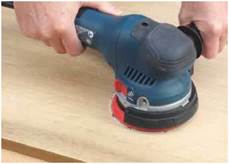
It can cope with pretty well anything from delicate, veneered boards to rough, reclaimed timber
it to be at this price. It’s comfortable to use, though you’ll need to use both hands when Turbo mode is selected. It can cope with pretty well anything from delicate, veneered boards to rough, reclaimed timber. Its high cost will probably restrict it to professional users, but shop around and you should find it for under £.
SPECIFICATION
Rated input power: 550W Sanding pad diameter: 125mm No-load speed: 3,300-7,800rpm Orbital stroke rate: 6,600-15,600opm Sanding pad speed: 200-480rpm Eccentricity: 1.75mm
Sanding sheet/disc attachment: Hook-and-loop fastening
Orbit diameter: 3.5mm Weight: 2.4kg
Dimensions (LxWxH): 349mm long x 147mm wide x 140mm
Web: www.bosch-pt.com
THE VERDICT
When you purchase through links on our site, I may earn an affiliate commission. Here’s how it works.







